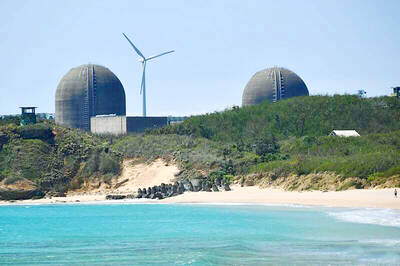“Forty-nine.”
On a Pacific beach in Costa Rica, a researcher whispers the number after counting the slimy, round white eggs just laid by a rare leatherback turtle in a hole dug in the sand under bright moonlight.
Turtles like this 1.5m-long female have probably been struggling out of the surf at night since before the dinosaurs disappeared 65 million years ago. The region is the main nesting site in the east Pacific for the critically endangered species.
Numbers of leatherbacks emerging onto this Costa Rican beach fell to 32 in the 2008 to 2009 season from 1,500 two decades ago — because of factors such as nearby hotels, poaching of eggs, accidental snaring in fishermen’s nets and global warming. Arrivals so far this season are slightly up.
Far from the beach, other experts may give a new argument for conserving the turtles by studying whether their fast-clotting blood can give clues to aiding humans, or if the way they regulate buoyancy can inform submarine design.
In 2010 — the International Year of Biodiversity — the UN wants efforts to slow the accelerating pace of extinctions to reach beyond nature lovers, to companies and economists.
Shifting emphasis from emotional images of polar bears, pandas or leatherbacks that stress the fragility and beauty of nature, the focus is on a harder-headed assessment of how the natural world is a key to economic growth and new products.
“Boosting biodiversity can boost the global economy,” the UN Environment Program said in a headline over a statement launching the theme. Natural services by coral reefs, forests or wetlands are too often undervalued, it said.
But profits from imitating nature have often been elusive. By some UN estimates, three species an hour are going extinct, most of them before they have even been identified.
“It’s like we have a house full of wedding presents,” said James Spotila, a professor of environmental science at Drexel University in Philadelphia. “And we’re throwing them out of the window before we even open them.”
EXTINCTION CRISIS
UN reports say the world is facing the worst spate of extinctions since the dinosaurs vanished, because of factors such as expanding cities, forest clearance, overfishing, climate change and species disrupting new habitats.
Yet a hectare of intact coral reef, for instance, can be worth up to US$1 million a year for tourism, up to US$189,000 for protecting coasts from storms, up to US$57,000 as a source of genetic materials and up to US$3,818 for fisheries, according to a preliminary UN-backed study late last year.
The problem is translating such estimates into cash.
“I always ask: ‘Where’s the business proposal?’” said Gunter Pauli, head of Zero Emissions Research and Initiatives, which looks for opportunities in nature.
Many pharmaceutical firms rely on nature. Among recent examples, scientists developed the malaria drug artemisinin from sweet wormwood, while the Madagascan periwinkle and Pacific yew tree have both yielded treatments for cancer.
Beyond medicines, firms are looking to “biomimicry,” tricks evolved by nature such as adhesives inspired by the feet of gecko lizards that can walk on ceilings, or cellphone screens imitating iridescent butterfly wings to generate colors.
Companies including Royal Dutch Shell, Dupont and Nike work with the Montana-based Biomimicry Guild, which seeks to identify new ideas.
“It’s so fun to see the light go on in their eyes. They can see: ‘We can make money and do the right thing,’” said Sherry Ritter of the Guild.
Still, Pauli said only three biomimicry products had secured annual turnover of more than 100 million euros (US$144.3 million).
These are Velcro — Swiss inventor George de Mestral was inspired in the 1940s by plant burrs trapped on his dog’s fur — hypodermic needles that Terumo Corp modeled on the jab of a mosquito, and paints derived from a self-cleaning trick by the lotus plant, sold by US Sto Corp and other groups.
ABALONE KEVLAR?
“A lot are nice, romantic ideas,” Pauli said. “The abalone [shellfish] produces materials stronger than Kevlar: correct. Commercial viability: zero. It’s too complicated.”
Among new business ideas, he said coffee farms in Colombia had created 10,000 jobs by using coffee waste as fertilizer to grow edible tropical mushrooms. In turn, the remaining waste can be sold as animal feed.
“If you say: ‘Can we talk about triple cash flows?’ then the entrepreneur gets interested,” he said, referring to the three income sources in such a project.
Studies showing the utilitarian value of nature are an extra reason for conservation, said Ahmed Djoghlaf, Executive Secretary of the Convention on Biological Diversity.
It is only natural that these approaches, and the new data they generate, are receiving more attention since their estimates are suddenly becoming more robust, he said.
“Biodiversity decline is predominantly caused by economic activities in the broadest sense, and the policy debate all too often tends to pit ‘economic’ interests against ‘environmental’ interests. The recent work shows that this juxtaposition is fundamentally flawed,” he said.
The “Copenhagen Accord,” agreed by some nations at UN climate talks last year, will also seek to promote the use of tropical forests to soak up greenhouse gases, a new source of income for poor nations.
Spotila, a leatherback turtle expert, said turtle blood is quick to clot to avoid giving sharks a scent that can bring an attack. Scientists are studying turtle blood for possible clues to stem bleeding in humans, for instance after surgery.
And the leatherbacks, the biggest species of turtle, can dive deeper than other turtles, leading experts to wonder how they regulate buoyancy. That and the shape of their shells could give clues to submarine or ship design.
The International Union for Conservation of Nature is seeking corporate sponsors to slow losses of species after the world failed to reach a UN goal, set in 2002, of slowing the rate of extinctions of animals and plants this year.
“We failed miserably,” said Jean-Christophe Vie, deputy head of IUCN’s species program. He said using economics to make the argument for protecting nature is often only stating the obvious.
“We need an economic argument, but I find it very sad,” he said. “Things like fisheries, timber, pollination, clean water. Can you imagine the size of the economy or company needed to [protect] that?”
On Playa Grande, researchers such as Tera Dornfeld mark the site of the eggs after the female turtle has filled in the hole with her giant rear flippers and returned to the ocean. Later, the eggs will be dug up and transferred to a hatchery.
In a local economic battle, park managers fear developers may win permission from politicians to develop hotels, roads and villas closer to the remote beach.
“I fear that more development here would be the final nail in the coffin for the turtles,” said Frank Paladino, professor of biology at Indiana’s Purdue University and director of research in the Las Baulas park that covers the beach.
In one sign of hope, an aging poster on the wall of the research center says the turtles could all be gone by this year. A turtle and her 49 eggs have proven that wrong.

July 28 to Aug. 3 Former president Chiang Kai-shek (蔣介石) reportedly maintained a simple diet and preferred to drink warm water — but one indulgence he enjoyed was a banned drink: Coca-Cola. Although a Coca-Cola plant was built in Taiwan in 1957, It was only allowed to sell to the US military and other American agencies. However, Chiang’s aides recall procuring the soft drink at US military exchange stores, and there’s also records of the Presidential Office ordering in bulk from Hong Kong. By the 1960s, it wasn’t difficult for those with means or connections to obtain Coca-Cola from the

Taiwan is today going to participate in a world-first experiment in democracy. Twenty-four Chinese Nationalist Party (KMT) lawmakers will face a recall vote, with the results determining if they keep their jobs. Some recalls look safe for the incumbents, other lawmakers appear heading for a fall and many could go either way. Predictions on the outcome vary widely, which is unsurprising — this is the first time worldwide a mass recall has ever been attempted at the national level. Even meteorologists are unclear what will happen. As this paper reported, the interactions between tropical storms Francisco and Com-May could lead to

A couple of weeks ago the parties aligned with the People’s Republic of China (PRC), the Chinese Nationalist Party (KMT) and the Taiwan People’s Party (TPP), voted in the legislature to eliminate the subsidy that enables Taiwan Power Co (Taipower) to keep up with its burgeoning debt, and instead pay for universal cash handouts worth NT$10,000. The subsidy would have been NT$100 billion, while the cash handout had a budget of NT$235 billion. The bill mandates that the cash payments must be completed by Oct. 31 of this year. The changes were part of the overall NT$545 billion budget approved

No one saw it coming. Everyone — including the Chinese Nationalist Party (KMT) — expected at least some of the recall campaigns against 24 of its lawmakers and Hsinchu Mayor Ann Kao (高虹安) to succeed. Underground gamblers reportedly expected between five and eight lawmakers to lose their jobs. All of this analysis made sense, but contained a fatal flaw. The record of the recall campaigns, the collapse of the KMT-led recalls, and polling data all pointed to enthusiastic high turnout in support of the recall campaigns, and that those against the recalls were unenthusiastic and far less likely to vote. That